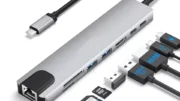To say that software development is fast-paced has become a bit cliche at this point, but sometimes expressions become cliche because they’re true. Software developers rely on efficiency to beat their competitors to market with similar ideas, and many others depend on it to appease an ever-changing consumer base. Either way, getting the most out of a development team is a main component of a software developer’s success.
Assuming that all the important factors are even between two competing software companies–skill set, versatility, expediency, and accuracy–the edge may occur elsewhere. Here we present the part of software development that often goes undervalued; that is, the environment in which your engineers operate. To that end, we’ve put together a checklist of office equipment that will make life easier for your development team, or even for yourself, if the plan is a solo endeavor.
Please note that these are the ideal equipment pieces for effectiveness rather than the most affordable. These won’t necessarily break the budget, but they are an investment that should pay off in terms of productivity, breakthroughs, and career advancement. That’s to say nothing of the positive effect on developer morale, which can often be the spark of creativity and talent retention, especially in a company that operates remotely.
The All-Important PC
Of course, the most important piece of equipment in any developer’s arsenal is their main computer. This topic could be an entire article itself if you ask developers, so we’ll stick with the consensus in terms of what works. You can assume that any piece of equipment we speak of here should be wireless whenever possible; you can also see “wire management” later in this article for more on how to avoid tangled masses of rubbery chaos under the desk.
- The personal computer (PC) – The first question that comes to mind when engaging in any intensive computer operations is always “how much power do I need?” There’s no set answer in this case since software development can occur with nothing more than a notepad application on a 20-year-old PC. Power requirements depend wholly on how much is needed to run your application again and again without waiting an hour for it to render.
- The Keyboard – Today, most programmers will tell you that mechanical keyboards are the way to go. A mechanical keyboard is referred to as such because its keys are operated via a specialized mechanism for quality feedback rather than the simple spring functionality of a standard keyboard. Compared to their standard counterparts, mechanical keyboards are more durable, more efficient in terms of latency, and generally more physically comfortable on the fingers.
- The Mouse – Many programming purists consider using the mouse taboo, but for those unburdened by tradition, a trackball mouse is the most responsive. These will have the same functionality as a regular mouse, with the added precision of the trackball for late-night coding sessions. If you’re not into changing the format, however, a high-end gaming mouse is made for long-lasting comfort and fast responses, so they can apply to any computer-related activity.
The Desk Setup
The areas surrounding your machine are also important. Consider your own tendencies–how often you swivel between screens, the nature of your desktop operation–before deciding on which equipment suits the office.
- The developer’s desk – There are many different desk styles to pick, and each depends on your desired aesthetic, and what you consider comfortable. Standing desks are good for circulation and overall health, but are not necessarily a long-term solution. The term ‘minimalist’ gets used a lot more often these days, reflecting a setup that’s just a flat table, with all the features hidden underneath such as a keyboard tray and wire clips. The L-shaped variant is good for people who like to swivel between monitors while they work, or for those who connect laptops to monitors. The important part is to make sure you have a good ratio of desk real estate to chair space, so you can move about both spaces unimpeded.
- The ergonomic chair – The term ‘ergonomic’ refers to any piece of furniture that is designed to support your muscles, specifically those in the lower back and posterior. Since software developers are prone to long hours behind the desk, an ergonomic computer chair is the most practical solution.
- Multi-monitor setups – Dual monitors are fairly commonplace in development offices, and these are usually matching widescreens of a size appropriate to the viewer. There is no right or wrong here, just a consideration that dual monitor setups require at least enough computing and GPU power to send a high-definition feed to two separate screens. Computer and monitor mounts are the ideal way to keep your screens at a favorable orientation to the chair.
The Must-Have Peripherals
This section includes some equipment that exists outside the standard fare, but should considered for any long-term software engineering setups:
- Productivity Boards – Virtually all programming teams use some type of digital productivity suite to keep things in line, but there is still value in the old-fashioned cork and whiteboards. These are a good way to keep our short and long-term goals in perspective.
- Wire Fixtures – These are usually rubber or plastic bindings that either tie groups of wires together or pin them to the bottom of tables. While we strive for wireless setups wherever possible, we also know tangled clusters are inevitable, so it’s better to invest early.
- Temperature Management – Aside from the inherent cooling apparatus inside your computer, some setups require extra fans and ventilation to avoid overheating parts.
- Backlights – Placed behind monitors, backlights lower the eyestrain of staring at bright monitors in a dark room for hours.
- Wrist pads – These are placed in front of the keyboard to lessen the wrist fatigue and discomfort caused by angular desk corners.
The Ideal Office
The idea behind creating the perfect programming space is to balance form and function. That is, we want to establish an ideal level of comfort for the long hours of sitting and typing, and then merge that with practical solutions for the challenges of software engineering.
If you’d like to know more about creating the ideal software workshop, consider our in-depth catalog for ideas and insights.





